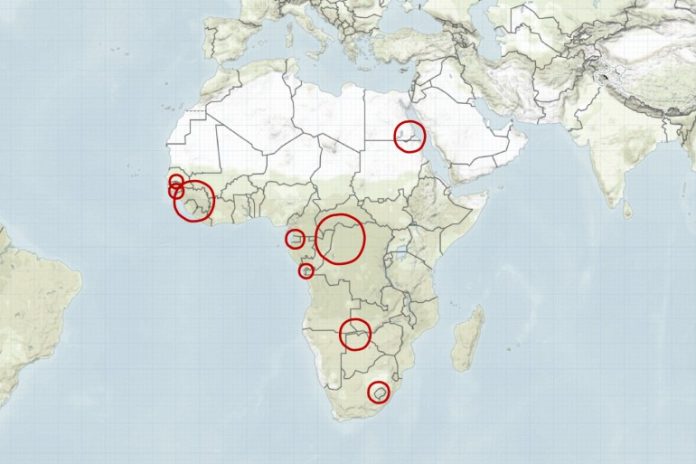Imagine a continent carved not by rivers or mountains, but by the stroke of a European pen.
This is the reality of Africa, where many borders, born from the 1884-85 Berlin Conference, remain etched on the landscape, dividing communities and fueling disputes. These lines, drawn without African input, are not just geographical; they’re living stories of a complex past.
Take, for example, the enigma of Bir Tawil. This arid, unclaimed land between Egypt and Sudan is a stark reminder of colonial cartography gone awry. Neither nation wants it, for claiming it means losing a more valuable territory. This silent, unwanted expanse speaks volumes about the arbitrary nature of these borders.
Egypt or Sudan – why does no one want Bir Tawil?
Starting in northeastern Africa is a 2,000sq-km (795sq-mile) uninhabited, arid piece of land that neither Egypt nor Sudan wants to claim as their own.
In 1899, Britain drew a straight-line border along the 22nd parallel, a line of latitude 22 degrees north of the equator, separating Egypt and Sudan, two territories under British control.
However, in 1902, Britain reassigned the coastal and resource-rich Hala’ib Triangle to Sudan and Bir Tawil to Egypt for geopolitical and administrative reasons.
Decades later, after both countries gained independence, Egypt insisted that the true border should follow the 1899 agreement while Sudan argued that it should follow the 1902 demarcation. Bir Tawil remains unclaimed by either country because claiming it would require forfeiting claims to the Hala’ib Triangle.
Egypt has controlled the Hala’ib Triangle since 2000, but the dispute remains unresolved.
Why is The Gambia so narrow?
Then there’s the slender form of The Gambia, a nation squeezed into a narrow strip along the Gambia River, a testament to British and French colonial rivalries. The legend of cannonballs determining its width might be a myth, but the reality is no less striking: a nation shaped by external forces, its fate tied to the whims of faraway powers.
First explored by the Portuguese in the 15th century, The Gambia later became a major hub in the transatlantic slave trade. It remained a British colony from 1821 until gaining independence in 1965. Due to its proximity to then-French Senegal, its territorial boundaries were a point of contention between British and French authorities.
In 1889, Britain and France formally established The Gambia’s borders, agreeing that British control would extend about 16km (10 miles) on either side of the river, reaching its furthest navigable point at Yarbutenda.
Ultimately, The Gambia’s borders were shaped by colonial interests and British military power, leaving it as a long, narrow enclave within Senegal.

Why is Cabinda part of Angola?
Further south, Cabinda’s separation from the rest of Angola by a sliver of the Democratic Republic of Congo tells a tale of resource-driven decisions. The promise of oil wealth, solidified during Portuguese rule, continues to fuel calls for independence, highlighting the enduring tension between imposed borders and local aspirations.
During the 1884-1885 Berlin Conference, Cabinda was formally recognised as a Portuguese possession, separate from Angola, although both were under Portuguese rule. Over time, Portugal administratively merged Cabinda with Angola, but the region remained geographically and culturally distinct.
When Portugal withdrew from its African colonies in 1975, the Alvor Agreement, signed with Angola’s main liberation groups, excluded Cabindan representation. and Cabinda was merged with Angola, primarily for its valuable offshore oil reserves.
This sparked resistance from the Cabindan independence movement, particularly the Front for the Liberation of the Enclave of Cabinda, which has continued to call for Cabinda’s independence from Angola.

Why does Namibia have a little panhandle?
The Caprivi Strip in Namibia, a narrow panhandle reaching for the Zambezi, reveals the absurdity of colonial ambitions. Germany’s failed attempt to secure a trade route, thwarted by the mighty Victoria Falls, stands as a symbol of European miscalculations and the disregard for local geography.
In the late 19th century, as European powers aggressively expanded their colonial holdings in Africa, Germany found itself in control of German South West Africa (present-day Namibia) and German East Africa (encompassing Tanzania, Rwanda, and Burundi). Simultaneously, Britain held sway over the surrounding territories, including modern-day Botswana and Zambia.
Driven by a desire to consolidate its African possessions and establish a direct trade route, Germany sought to connect its two colonies. Their ambitious plan centered on gaining access to the Zambezi River, envisioning a navigable waterway that would lead to the Indian Ocean, effectively creating a shortcut to German East Africa.
To achieve this goal, Germany engaged in negotiations with Britain, culminating in the 1890 Heligoland-Zanzibar Treaty. In this agreement, Germany relinquished its claims to the strategically important island of Zanzibar in exchange for the Caprivi Strip, a narrow corridor that extended eastward and reached the Zambezi River. However, Germany’s carefully laid plans were thwarted by a significant geographical obstacle: Victoria Falls.
Unbeknownst to the German planners, or perhaps overlooked in their eagerness, the Zambezi River was interrupted by one of the world’s most spectacular waterfalls, featuring a dramatic 108-meter drop. Located approximately 65 kilometers east of the Caprivi Strip, Victoria Falls rendered the river impassable for the intended trade route, effectively nullifying the purpose of acquiring the territory. This oversight underscored the often-limited understanding that European powers had of the African landscape, despite their efforts to carve up the continent.

Why is Lesotho surrounded by South Africa?
And consider Lesotho, a mountain kingdom entirely encircled by South Africa. Its survival as an independent nation, born from a strategic alliance with the British against Boer expansion, underscores the resilience of African communities in the face of colonial pressures.
In the 19th century, the Basotho people, led by King Moshoeshoe I, established their stronghold in the highlands, using the mountains as a natural defence against invaders like the Zulu and Boer settlers (Dutch farmers).
To resist Boer expansion, Moshoeshoe sought British protection in 1868, making Basutoland a British protectorate.
Attempts to place it under Colonial Cape rule failed due to Basotho resistance, and in 1884, Britain declared it a crown colony.
When the Union of South Africa formed in 1910, Basutoland remained under British rule, avoiding South Africa’s apartheid policies, and later gained independence in 1966 as Lesotho.

Why are three African countries named Guinea?
Four countries around the world have “Guinea” in their names, three of which are along the West African coast.
They are:
- Guinea, formerly known as French Guinea, gained independence in 1958 and kept the name Guinea.
- Guinea-Bissau, formerly known as Portuguese Guinea, gained independence in 1974 and added “Bissau” to its name to differentiate itself from neighbouring Guinea.
- Equatorial Guinea, formerly known as Spanish Guinea, gained independence in 1968 and added Equatorial to its name because it is near the equator.
On the other side of the world lies Papua New Guinea, named by a Spanish explorer who named it after Guinea in West Africa, believing the locals resembled its inhabitants.
The very names of nations, like the three Guineas, echo the echoes of colonial nomenclature, each telling a story of distinct colonial rule. Even the two Congos, separated by a river but united by a shared name, reveal the lasting imprint of Belgian and French influence.

Why are there two Congos?
On opposite sides of the Congo River lie two countries named after it: the Democratic Republic of the Congo and the Republic of the Congo.
Colonial powers Belgium and France established separate colonies along the river, naming each after it. The name Congo comes from the Kingdom of Kongo, a powerful kingdom that once flourished along the river.

These are not just lines on a map. They are the scars of history, the sources of ongoing disputes, and the foundations of national identities. They raise fundamental questions: How do artificial borders shape a nation’s destiny? What are the human costs of colonial cartography? And how do these borders continue to influence Africa’s present and future?
By delving into these stories, we gain a deeper understanding of Africa’s complex tapestry, a continent forever marked by the lines drawn by those who never truly understood its lands or its people.
Like 👍, Comment, share this article, and Follow us on our social media handles.







